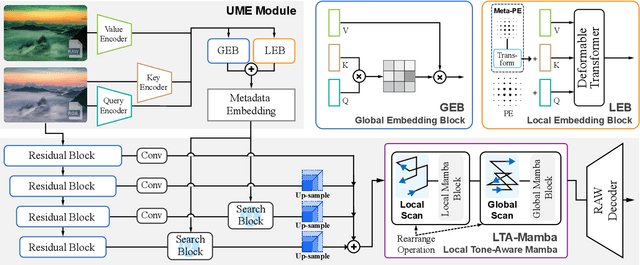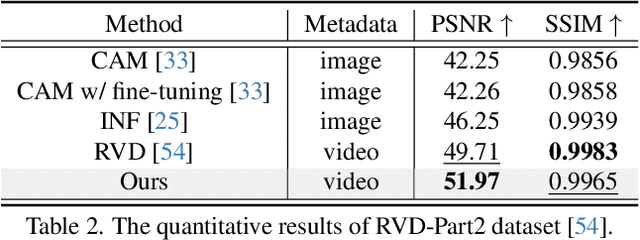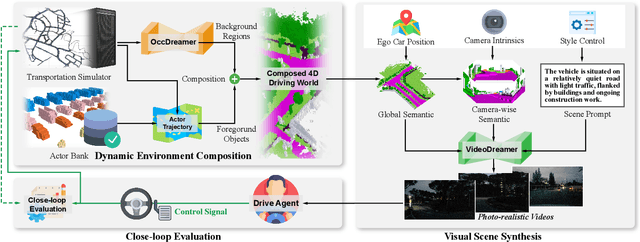Wencheng Han
Self-Rewarding Large Vision-Language Models for Optimizing Prompts in Text-to-Image Generation
May 22, 2025Abstract:Text-to-image models are powerful for producing high-quality images based on given text prompts, but crafting these prompts often requires specialized vocabulary. To address this, existing methods train rewriting models with supervision from large amounts of manually annotated data and trained aesthetic assessment models. To alleviate the dependence on data scale for model training and the biases introduced by trained models, we propose a novel prompt optimization framework, designed to rephrase a simple user prompt into a sophisticated prompt to a text-to-image model. Specifically, we employ the large vision language models (LVLMs) as the solver to rewrite the user prompt, and concurrently, employ LVLMs as a reward model to score the aesthetics and alignment of the images generated by the optimized prompt. Instead of laborious human feedback, we exploit the prior knowledge of the LVLM to provide rewards, i.e., AI feedback. Simultaneously, the solver and the reward model are unified into one model and iterated in reinforcement learning to achieve self-improvement by giving a solution and judging itself. Results on two popular datasets demonstrate that our method outperforms other strong competitors.
Towards Better Cephalometric Landmark Detection with Diffusion Data Generation
May 09, 2025Abstract:Cephalometric landmark detection is essential for orthodontic diagnostics and treatment planning. Nevertheless, the scarcity of samples in data collection and the extensive effort required for manual annotation have significantly impeded the availability of diverse datasets. This limitation has restricted the effectiveness of deep learning-based detection methods, particularly those based on large-scale vision models. To address these challenges, we have developed an innovative data generation method capable of producing diverse cephalometric X-ray images along with corresponding annotations without human intervention. To achieve this, our approach initiates by constructing new cephalometric landmark annotations using anatomical priors. Then, we employ a diffusion-based generator to create realistic X-ray images that correspond closely with these annotations. To achieve precise control in producing samples with different attributes, we introduce a novel prompt cephalometric X-ray image dataset. This dataset includes real cephalometric X-ray images and detailed medical text prompts describing the images. By leveraging these detailed prompts, our method improves the generation process to control different styles and attributes. Facilitated by the large, diverse generated data, we introduce large-scale vision detection models into the cephalometric landmark detection task to improve accuracy. Experimental results demonstrate that training with the generated data substantially enhances the performance. Compared to methods without using the generated data, our approach improves the Success Detection Rate (SDR) by 6.5%, attaining a notable 82.2%. All code and data are available at: https://um-lab.github.io/cepha-generation
Geometry-aware Temporal Aggregation Network for Monocular 3D Lane Detection
Apr 29, 2025Abstract:Monocular 3D lane detection aims to estimate 3D position of lanes from frontal-view (FV) images. However, current monocular 3D lane detection methods suffer from two limitations, including inaccurate geometric information of the predicted 3D lanes and difficulties in maintaining lane integrity. To address these issues, we seek to fully exploit the potential of multiple input frames. First, we aim at enhancing the ability to perceive the geometry of scenes by leveraging temporal geometric consistency. Second, we strive to improve the integrity of lanes by revealing more instance information from temporal sequences. Therefore, we propose a novel Geometry-aware Temporal Aggregation Network (GTA-Net) for monocular 3D lane detection. On one hand, we develop the Temporal Geometry Enhancement Module (TGEM), which exploits geometric consistency across successive frames, facilitating effective geometry perception. On the other hand, we present the Temporal Instance-aware Query Generation (TIQG), which strategically incorporates temporal cues into query generation, thereby enabling the exploration of comprehensive instance information. Experiments demonstrate that our GTA-Net achieves SoTA results, surpassing existing monocular 3D lane detection solutions.
Reducing CT Metal Artifacts by Learning Latent Space Alignment with Gemstone Spectral Imaging Data
Mar 27, 2025Abstract:Metal artifacts in CT slices have long posed challenges in medical diagnostics. These artifacts degrade image quality, resulting in suboptimal visualization and complicating the accurate interpretation of tissues adjacent to metal implants. To address these issues, we introduce the Latent Gemstone Spectral Imaging (GSI) Alignment Framework, which effectively reduces metal artifacts while avoiding the introduction of noise information. Our work is based on a key finding that even artifact-affected ordinary CT sequences contain sufficient information to discern detailed structures. The challenge lies in the inability to clearly represent this information. To address this issue, we developed an Alignment Framework that adjusts the representation of ordinary CT images to match GSI CT sequences. GSI is an advanced imaging technique using multiple energy levels to mitigate artifacts caused by metal implants. By aligning the representation to GSI data, we can effectively suppress metal artifacts while clearly revealing detailed structure, without introducing extraneous information into CT sequences. To facilitate the application, we propose a new dataset, Artifacts-GSI, captured from real patients with metal implants, and establish a new benchmark based on this dataset. Experimental results show that our method significantly reduces metal artifacts and greatly enhances the readability of CT slices. All our code and data are available at: https://um-lab.github.io/GSI-MAR/
DC-ControlNet: Decoupling Inter- and Intra-Element Conditions in Image Generation with Diffusion Models
Feb 20, 2025Abstract:In this paper, we introduce DC (Decouple)-ControlNet, a highly flexible and precisely controllable framework for multi-condition image generation. The core idea behind DC-ControlNet is to decouple control conditions, transforming global control into a hierarchical system that integrates distinct elements, contents, and layouts. This enables users to mix these individual conditions with greater flexibility, leading to more efficient and accurate image generation control. Previous ControlNet-based models rely solely on global conditions, which affect the entire image and lack the ability of element- or region-specific control. This limitation reduces flexibility and can cause condition misunderstandings in multi-conditional image generation. To address these challenges, we propose both intra-element and Inter-element Controllers in DC-ControlNet. The Intra-Element Controller handles different types of control signals within individual elements, accurately describing the content and layout characteristics of the object. For interactions between elements, we introduce the Inter-Element Controller, which accurately handles multi-element interactions and occlusion based on user-defined relationships. Extensive evaluations show that DC-ControlNet significantly outperforms existing ControlNet models and Layout-to-Image generative models in terms of control flexibility and precision in multi-condition control.
RAWMamba: Unified sRGB-to-RAW De-rendering With State Space Model
Nov 18, 2024



Abstract:Recent advancements in sRGB-to-RAW de-rendering have increasingly emphasized metadata-driven approaches to reconstruct RAW data from sRGB images, supplemented by partial RAW information. In image-based de-rendering, metadata is commonly obtained through sampling, whereas in video tasks, it is typically derived from the initial frame. The distinct metadata requirements necessitate specialized network architectures, leading to architectural incompatibilities that increase deployment complexity. In this paper, we propose RAWMamba, a Mamba-based unified framework developed for sRGB-to-RAW de-rendering across both image and video domains. The core of RAWMamba is the Unified Metadata Embedding (UME) module, which harmonizes diverse metadata types into a unified representation. In detail, a multi-perspective affinity modeling method is proposed to promote the extraction of reference information. In addition, we introduce the Local Tone-Aware Mamba (LTA-Mamba) module, which captures long-range dependencies to enable effective global propagation of metadata. Experimental results demonstrate that the proposed RAWMamba achieves state-of-the-art performance, yielding high-quality RAW data reconstruction.
DrivingSphere: Building a High-fidelity 4D World for Closed-loop Simulation
Nov 18, 2024



Abstract:Autonomous driving evaluation requires simulation environments that closely replicate actual road conditions, including real-world sensory data and responsive feedback loops. However, many existing simulations need to predict waypoints along fixed routes on public datasets or synthetic photorealistic data, \ie, open-loop simulation usually lacks the ability to assess dynamic decision-making. While the recent efforts of closed-loop simulation offer feedback-driven environments, they cannot process visual sensor inputs or produce outputs that differ from real-world data. To address these challenges, we propose DrivingSphere, a realistic and closed-loop simulation framework. Its core idea is to build 4D world representation and generate real-life and controllable driving scenarios. In specific, our framework includes a Dynamic Environment Composition module that constructs a detailed 4D driving world with a format of occupancy equipping with static backgrounds and dynamic objects, and a Visual Scene Synthesis module that transforms this data into high-fidelity, multi-view video outputs, ensuring spatial and temporal consistency. By providing a dynamic and realistic simulation environment, DrivingSphere enables comprehensive testing and validation of autonomous driving algorithms, ultimately advancing the development of more reliable autonomous cars. The benchmark will be publicly released.
Towards High-Fidelity 3D Portrait Generation with Rich Details by Cross-View Prior-Aware Diffusion
Nov 15, 2024Abstract:Recent diffusion-based Single-image 3D portrait generation methods typically employ 2D diffusion models to provide multi-view knowledge, which is then distilled into 3D representations. However, these methods usually struggle to produce high-fidelity 3D models, frequently yielding excessively blurred textures. We attribute this issue to the insufficient consideration of cross-view consistency during the diffusion process, resulting in significant disparities between different views and ultimately leading to blurred 3D representations. In this paper, we address this issue by comprehensively exploiting multi-view priors in both the conditioning and diffusion procedures to produce consistent, detail-rich portraits. From the conditioning standpoint, we propose a Hybrid Priors Diffsion model, which explicitly and implicitly incorporates multi-view priors as conditions to enhance the status consistency of the generated multi-view portraits. From the diffusion perspective, considering the significant impact of the diffusion noise distribution on detailed texture generation, we propose a Multi-View Noise Resamplig Strategy integrated within the optimization process leveraging cross-view priors to enhance representation consistency. Extensive experiments demonstrate that our method can produce 3D portraits with accurate geometry and rich details from a single image. The project page is at \url{https://haoran-wei.github.io/Portrait-Diffusion}.
ALOcc: Adaptive Lifting-based 3D Semantic Occupancy and Cost Volume-based Flow Prediction
Nov 12, 2024Abstract:Vision-based semantic occupancy and flow prediction plays a crucial role in providing spatiotemporal cues for real-world tasks, such as autonomous driving. Existing methods prioritize higher accuracy to cater to the demands of these tasks. In this work, we strive to improve performance by introducing a series of targeted improvements for 3D semantic occupancy prediction and flow estimation. First, we introduce an occlusion-aware adaptive lifting mechanism with a depth denoising technique to improve the robustness of 2D-to-3D feature transformation and reduce the reliance on depth priors. Second, we strengthen the semantic consistency between 3D features and their original 2D modalities by utilizing shared semantic prototypes to jointly constrain both 2D and 3D features. This is complemented by confidence- and category-based sampling strategies to tackle long-tail challenges in 3D space. To alleviate the feature encoding burden in the joint prediction of semantics and flow, we propose a BEV cost volume-based prediction method that links flow and semantic features through a cost volume and employs a classification-regression supervision scheme to address the varying flow scales in dynamic scenes. Our purely convolutional architecture framework, named ALOcc, achieves an optimal tradeoff between speed and accuracy achieving state-of-the-art results on multiple benchmarks. On Occ3D and training without the camera visible mask, our ALOcc achieves an absolute gain of 2.5\% in terms of RayIoU while operating at a comparable speed compared to the state-of-the-art, using the same input size (256$\times$704) and ResNet-50 backbone. Our method also achieves 2nd place in the CVPR24 Occupancy and Flow Prediction Competition.
Decoupling Fine Detail and Global Geometry for Compressed Depth Map Super-Resolution
Nov 05, 2024Abstract:Recovering high-quality depth maps from compressed sources has gained significant attention due to the limitations of consumer-grade depth cameras and the bandwidth restrictions during data transmission. However, current methods still suffer from two challenges. First, bit-depth compression produces a uniform depth representation in regions with subtle variations, hindering the recovery of detailed information. Second, densely distributed random noise reduces the accuracy of estimating the global geometric structure of the scene. To address these challenges, we propose a novel framework, termed geometry-decoupled network (GDNet), for compressed depth map super-resolution that decouples the high-quality depth map reconstruction process by handling global and detailed geometric features separately. To be specific, we propose the fine geometry detail encoder (FGDE), which is designed to aggregate fine geometry details in high-resolution low-level image features while simultaneously enriching them with complementary information from low-resolution context-level image features. In addition, we develop the global geometry encoder (GGE) that aims at suppressing noise and extracting global geometric information effectively via constructing compact feature representation in a low-rank space. We conduct experiments on multiple benchmark datasets, demonstrating that our GDNet significantly outperforms current methods in terms of geometric consistency and detail recovery. In the ECCV 2024 AIM Compressed Depth Upsampling Challenge, our solution won the 1st place award. Our codes will be available.
 Add to Chrome
Add to Chrome Add to Firefox
Add to Firefox Add to Edge
Add to Edge